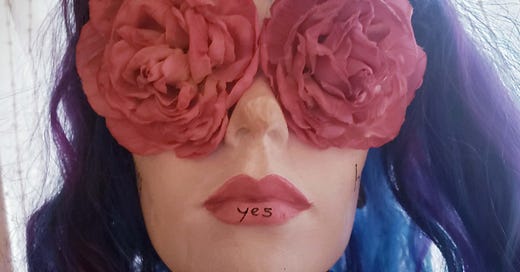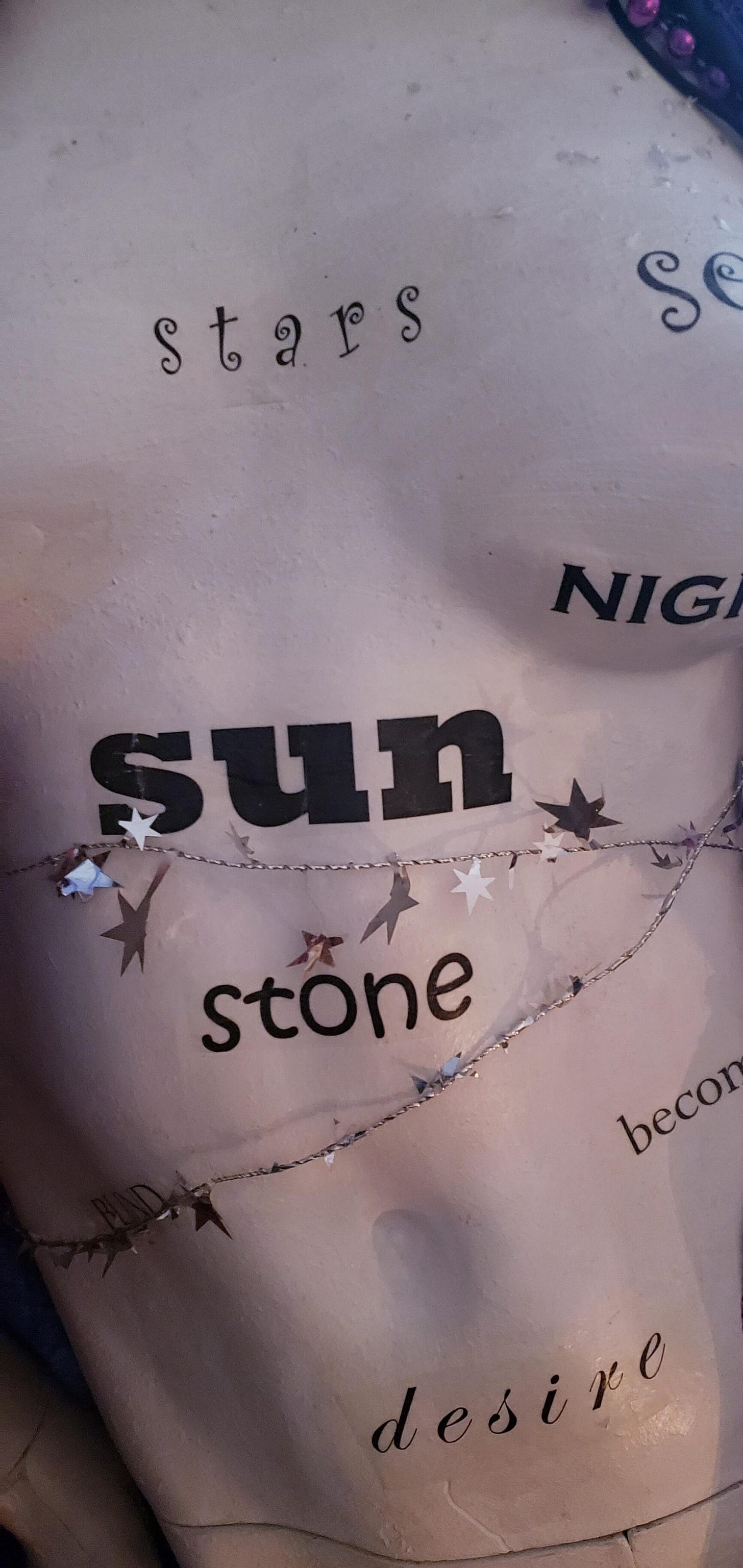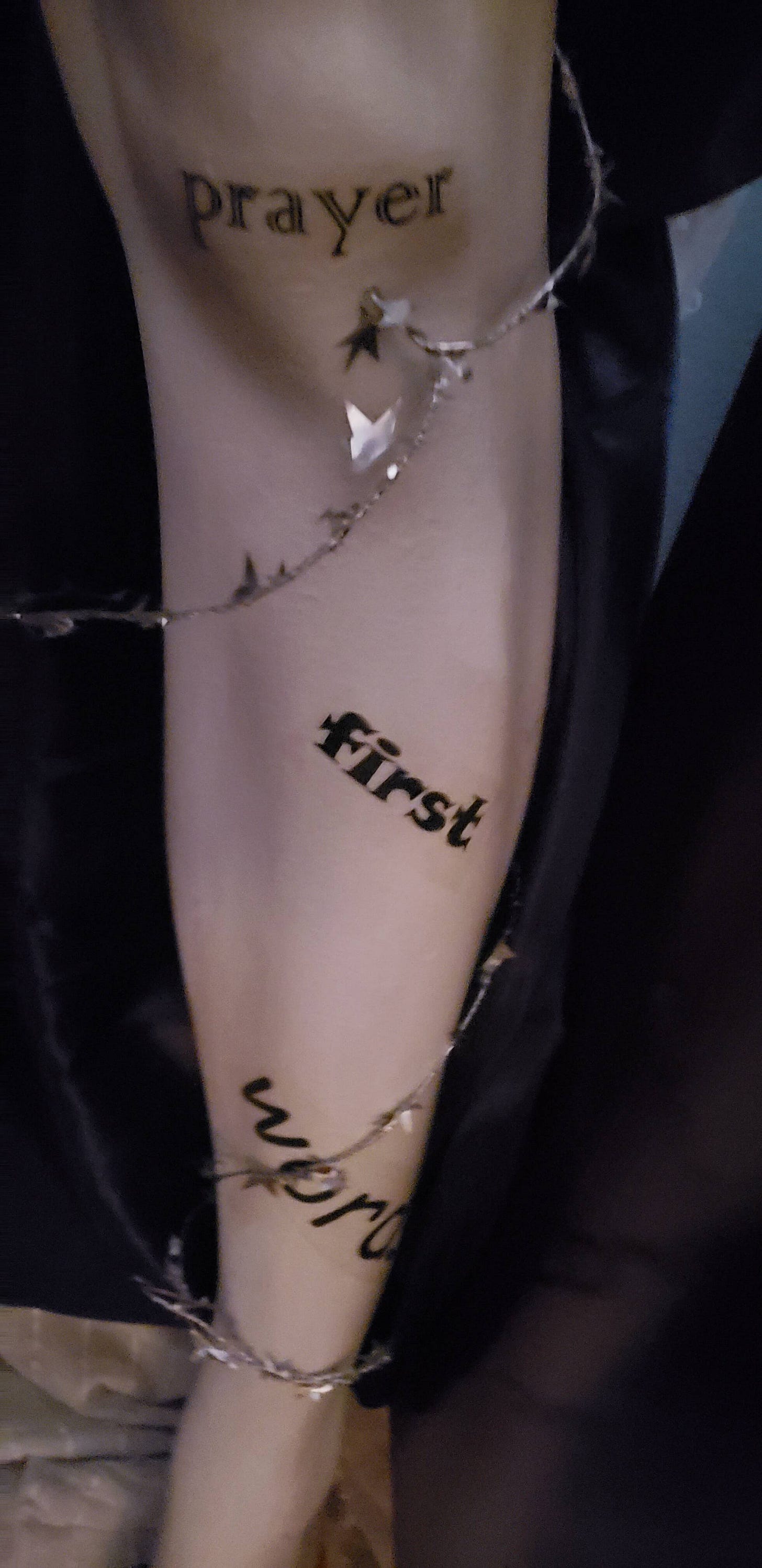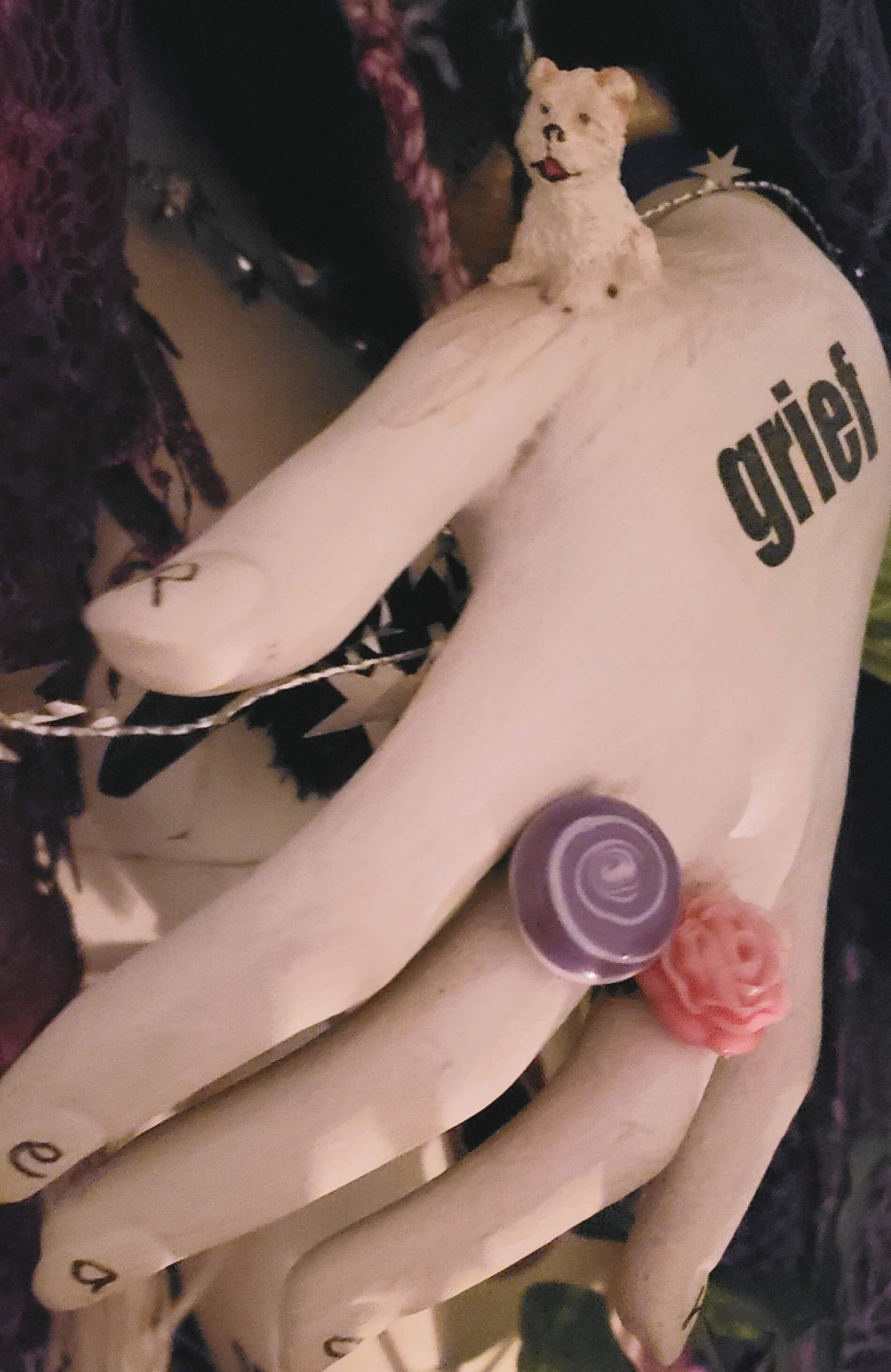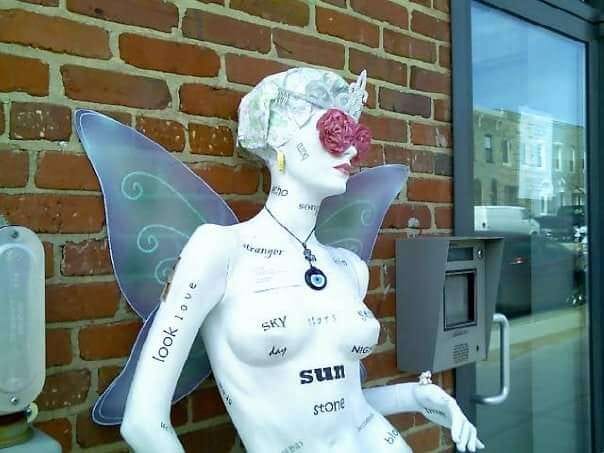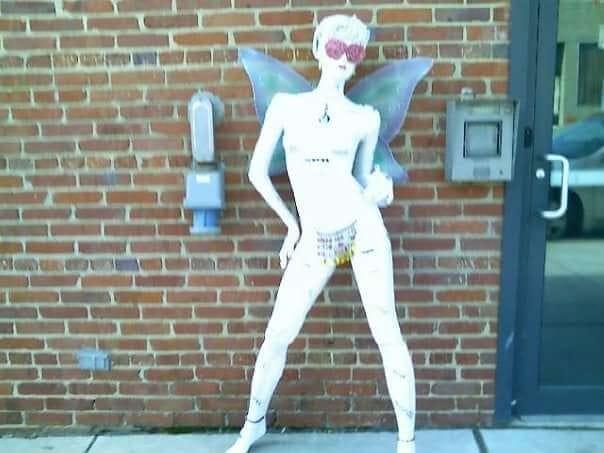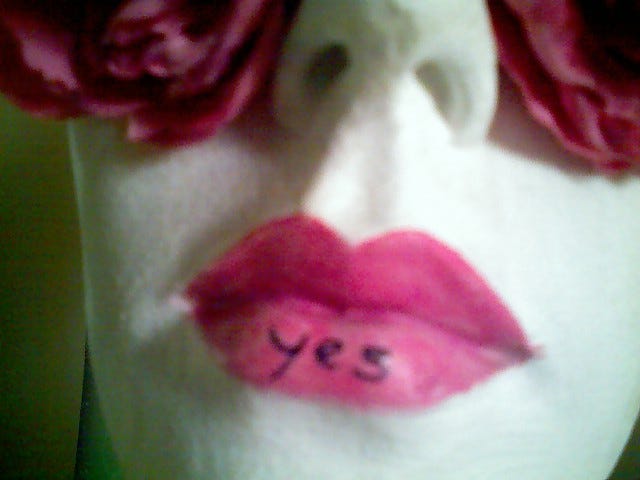I found Solange on a snowy February day in a towering brick mannequin factory owned by an artist in Baltimore, where hundreds of mannequin torsos and legs hung from racks of hooks or chains attached to the ceiling and metal shelves and laundry bins of heads, arms, and hands filled the floor.
But first, let’s go back a bit.
Artist Residency
In 2005 I was awarded an artist residency at Creative Alliance, an arts and humanities nonprofit housed in an old movie theater (The Patterson) in the neighborhood of Highlandtown in Baltimore. It’s two blocks from Patterson Park, which played a role in the Battle of Baltimore in the War of 1812 and is considered to be a mini Central Park—an oasis of green and trees in the city.
At The Patterson there are eight loft studios artists can live in, if they choose (which I did), and artists could stay three years (which I also did). The space was renovated and still contains the movie theater (now a performance space), but around it are galleries, classrooms, studios, offices, and a bar/restaurant.
My studio, #8, was one of the larger ones. It had a polished cement floor, huge metal beams crisscrossing the 30 foot ceiling, a brick wall on one side and huge white walls everywhere else, where I later wrote poems in charcoal. Most of one wall was a floor to ceiling window where my Westie, Keegan, camped out most days, barking at the frequent buses and the people who dared cross his path. (He took his role as protector of the building very seriously).

A loft stretched across one-third of the space but the steep ladder made it unusable for me (no way was I going to navigate that ladder in the middle of the night to go to the bathroom, or try to carry Keegan up at bedtime, let alone down. And there wasn’t a railing. Later, a spiral staircase and a railing were installed, and eventually I moved my writing space up there, which was cool). I loved that I could make a mess—the space was built for that—and set to work on one of the plans I’d shared in my application—creating a series of visual poems.
This idea is tangentially linked to my “Ekphrastic Magic” post, in that it was marrying image and text and layering metaphor and symbol. In my ekphrasis post, I mentioned that sometimes those poems are also fashioned in the shape of the subject of the poem. Shaped poetry is also visual poetry. There are many versions of visual poetry, and I was influenced by concrete poetry, haptic poetry, and intermedia.
That said, I don’t profess to be an expert on these forms and I am not a painter or sculptor. What I wanted to create was a 4D, interactive piece around one of my poems. By interactive, I mean I wanted to incorporate time and capture the moment of the poem itself or to embody its meaning in a physical form, including the text of the poem.
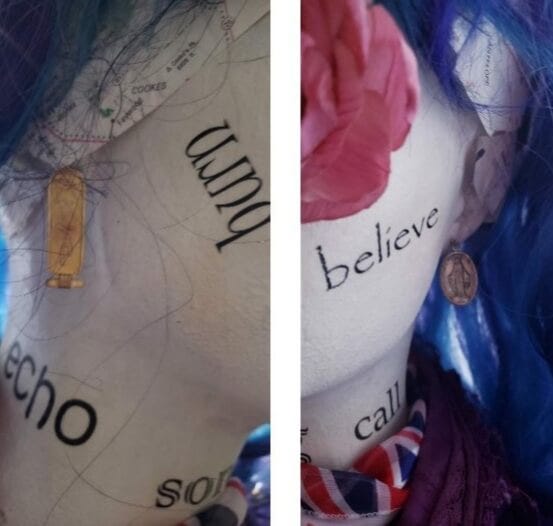
The Poem
Solange wasn’t the first of these pieces, but she was the most ambitious and took the longest to create. Each one started with a poem that I could picture in some physical form (I’ll share them in other newsletters). She was inspired by a tag cloud feature on Amazon that I don’t think exists anymore: concordance. When on the page for a book you were interested in, if you clicked on the word concordance near the title, it gave you a list of the top 100 words used most frequently in the book. Further, you could see how many times the word occurred and on what pages.
It made me wonder what my top 100 words were and I pulled out my poetry manuscripts in various stages of completion and all the poems in progress I could gather and made lists of words that seemed to crop up a lot. It was a very unscientific, inexact process!
Here’s what I ended up with:
100 WORDS
again alone always another away becomes
believe birds blind blood bloom bones burn
call chance come cold day dark dead desire
different door down dreams dust echo empty
end evening ever eyes fall flare first ghost
glass gone grief hands heart house inside itself
keeping left life light little long look love missing
moon morning new next night nothing now
open prayer rain reach release safe sea single
skin sky sleep smaller snow song soon stars
still stone storm stranger sun tell things time
tongue turns two vibrate voice wants watch wave
web white wind winter words world years yes
I knew this visual poem had to be a self-portrait piece and that it had to involve a mannequin painted white with these words all over her like words on a page. That’s how I pictured it.
The Mannequin
I got incredibly lucky on my first attempt to find a mannequin. I can’t remember if I used the yellow pages or Yahoo—maybe both. The first listing I found was a place in Baltimore that turned out to be the studio of Lania D’Agostino, a painter/sculptor who I later learned had worked with Lucas Films (as in George Lucas—Star Wars, Lord of the Rings…. Read about D’Agostino and see pics of her space and work).
We arranged to meet but must have gotten our wires crossed as she didn’t sell the mannequins (do not call her trying to buy one!) but graciously agreed to let me purchase one as an exception. I could have wandered around for hours in that surreal, fascinating space, made more surreal by the cold, gloomy February weather, which started as rain and turned to snow while I was there. I quickly chose a torso, a head (I wanted one with pierced ears—hard to find!), legs, and arms with hands. I wanted arms that were bent, not straight, and the best one I found had a hand that was missing a finger, but I figured I could fill that in with a pen (get it? :) )
I drove her home in pieces in clear plastic bags in my trunk and slipped and slid through the snow carrying her to my studio where I laid her out on the floor. Keegan sniffed all of the parts, then sat next to her head looking at me suspiciously. Once I put her together he got used to her and as I worked on the project, he would lie on the floor between her feet. I still wonder if he thought she was real—strange, but real.
The Process
It took about 15 coats of gesso to cover her completely. She was a pinkish color with short, molded, wavy blonde hair and the hair was difficult to hide. For the poem I taped tracing paper to regular paper and printed out the words, which I had changed into many different fonts. I cut each one out and fixed them with medium so they would blend in, then covered her entirely with many, many, many coats of medium to prevent her yellowing. It’s inevitable though, and she needs some touching up here and there.
The hardest part was her eyes. I knew I wanted roses in her eyes (rose-colored glasses) so I had to poke holes in them with a screwdriver and a hammer. She had such a serious, melancholy look that the first blow made me feel a little sick. I expected her to cry out. Two hits with the hammer, the black pupil chipped to white, and it was done. I worked in the stems of the fake flowers and glue ran down her cheeks like tears. A bizarre moment.
From there I added little embellishments—around her hair I wrapped a map of New Mexico (where my car broke down spectacularly on a trip across country, and while the engine was replaced (yep!) I stayed at the mechanic’s apartment in Albuquerque—a story for another time…), a picture of me at six years old, an Edgar Allan Poe band aid, chakra mandalas down her back, kitschy bracelets and rings and fun scarves. A little Keegan on her hand so they are always together.
I painted her toes purple. I added a dice necklace from Johns Hopkins’ Children’s Hospital annual fundraiser called “Night of 100 Elvises” (wall to wall impersonators, everyone dressed in 50s, 60s, and 70s outfits, three floors of performances, casino games, Elvis’ favorite foods—an absolutely fabulous crazy dance party). For a while she wore fairy wings and strands of white lights. She looks fantastic in hats. I still decorate her at Christmas and right now she’s wearing a purple spider cape and blue wig from a Halloween costume a few years ago.
Sixteen years later, I can’t imagine a life without Solange, which I named her because it’s a French name I love and because it means “solemn” or “dignified” and a more imaginative “angel of the sun,” things that completely contradict what I’ve done with her—a fun juxtaposition. She’s constantly evolving and I change up what she’s decorated with regularly depending on how I feel and what’s going on (or not going on) in my life. She’s a physical reminder of a very special experience and of what’s important to me.
There are more of these projects that I would like to create, as part of this newsletter, and I’ll take you along with me through the process when I do!
Create Your Own Self-Portrait
What might your self-portrait piece look like? It doesn’t have to be a mannequin, but there are options on Amazon under $100 if that’s the way you’d like to go. Here are some ideas:
Trace your body outline on butcher paper and collage it
Create something digital on your computer or phone using Canva
Stage a room in your home and take a photograph of it
Paint, sculpt, make something out of paper mache or a mosaic
Buy a plastic or fabric doll already made and alter it any way you like
Sew, paint, collage a piece of clothing (shirt, dress, coat) or use a towel or blanket
Write a poem, an essay, a song, or piece of music
Make something out of macaroni like when you were in kid
Make something out of clay, wax, flowers, wood, yarn (knit your self-portrait!)
Design a self-portrait garden
Cook a self-portrait meal or dessert
Create a perfume—what’s your signature “you” scent?
Make a mixtape (compilation CD depending on your generation)
Fill a box of things that represent you in this moment and update it every month, or write the date on it and open it in six months or two years.
The possibilities are endless! Whatever calls to you, Solange’s advice is to say:
Happy writing,
Chris & Solange
Next let’s get into the cracks with some Wabi-sabi writing.


